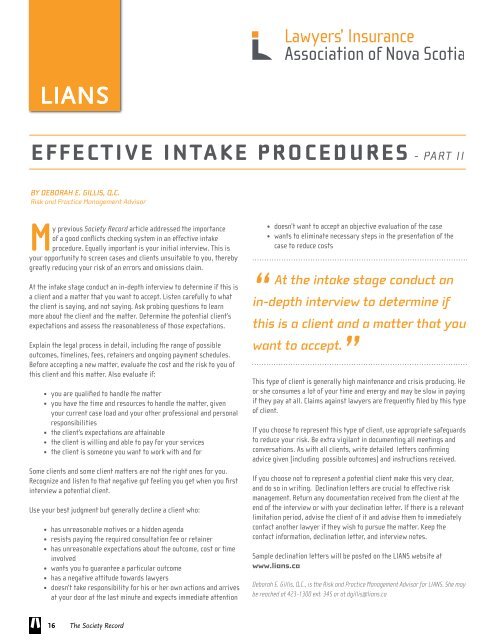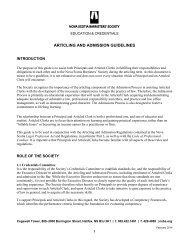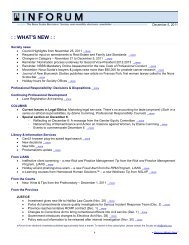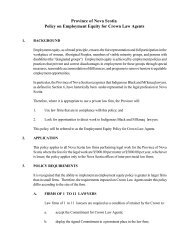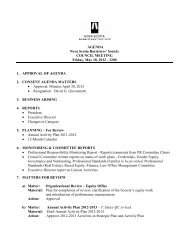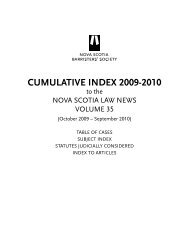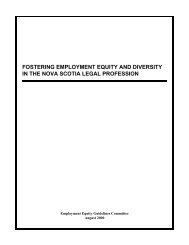SR Vol 24 No 5, October 2006 - Nova Scotia Barristers' Society
SR Vol 24 No 5, October 2006 - Nova Scotia Barristers' Society
SR Vol 24 No 5, October 2006 - Nova Scotia Barristers' Society
- No tags were found...
You also want an ePaper? Increase the reach of your titles
YUMPU automatically turns print PDFs into web optimized ePapers that Google loves.
LIANSEffective Intake Procedures - Part IIby Deborah E. Gillis, Q.C.Risk and Practice Management AdvisorMy previous <strong>Society</strong> Record article addressed the importanceof a good conflicts checking system in an effective intakeprocedure. Equally important is your initial interview. This isyour opportunity to screen cases and clients unsuitable to you, therebygreatly reducing your risk of an errors and omissions claim.At the intake stage conduct an in-depth interview to determine if this isa client and a matter that you want to accept. Listen carefully to whatthe client is saying, and not saying. Ask probing questions to learnmore about the client and the matter. Determine the potential client’sexpectations and assess the reasonableness of those expectations.Explain the legal process in detail, including the range of possibleoutcomes, timelines, fees, retainers and ongoing payment schedules.Before accepting a new matter, evaluate the cost and the risk to you ofthis client and this matter. Also evaluate if:• you are qualified to handle the matter• you have the time and resources to handle the matter, givenyour current case load and your other professional and personalresponsibilities• the client’s expectations are attainable• the client is willing and able to pay for your services• the client is someone you want to work with and forSome clients and some client matters are not the right ones for you.Recognize and listen to that negative gut feeling you get when you firstinterview a potential client.Use your best judgment but generally decline a client who:• has unreasonable motives or a hidden agenda• resists paying the required consultation fee or retainer• has unreasonable expectations about the outcome, cost or timeinvolved• wants you to guarantee a particular outcome• has a negative attitude towards lawyers• doesn’t take responsibility for his or her own actions and arrivesat your door at the last minute and expects immediate attention“• doesn’t want to accept an objective evaluation of the case• wants to eliminate necessary steps in the presentation of thecase to reduce costsAt the intake stage conduct anin-depth interview to determine ifthis is a client and a matter that youwant to accept. ”This type of client is generally high maintenance and crisis producing. Heor she consumes a lot of your time and energy and may be slow in payingif they pay at all. Claims against lawyers are frequently filed by this typeof client.If you choose to represent this type of client, use appropriate safeguardsto reduce your risk. Be extra vigilant in documenting all meetings andconversations. As with all clients, write detailed letters confirmingadvice given (including possible outcomes) and instructions received.If you choose not to represent a potential client make this very clear,and do so in writing. Declination letters are crucial to effective riskmanagement. Return any documentation received from the client at theend of the interview or with your declination letter. If there is a relevantlimitation period, advise the client of it and advise them to immediatelycontact another lawyer if they wish to pursue the matter. Keep thecontact information, declination letter, and interview notes.Sample declination letters will be posted on the LIANS website atwww.lians.caDeborah E. Gillis, Q.C., is the Risk and Practice Management Advisor for LIANS. She maybe reached at 423-1300 ext. 345 or at dgillis@lians.ca16 The <strong>Society</strong> Record


